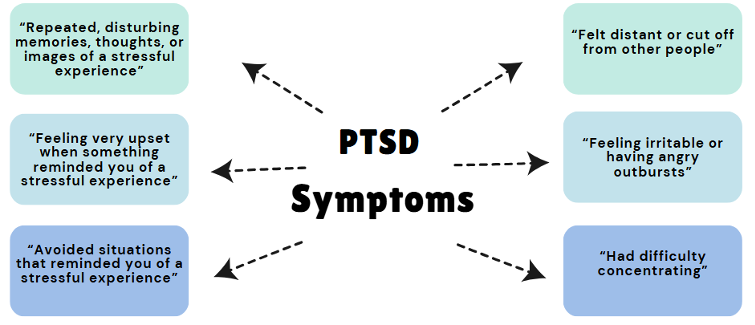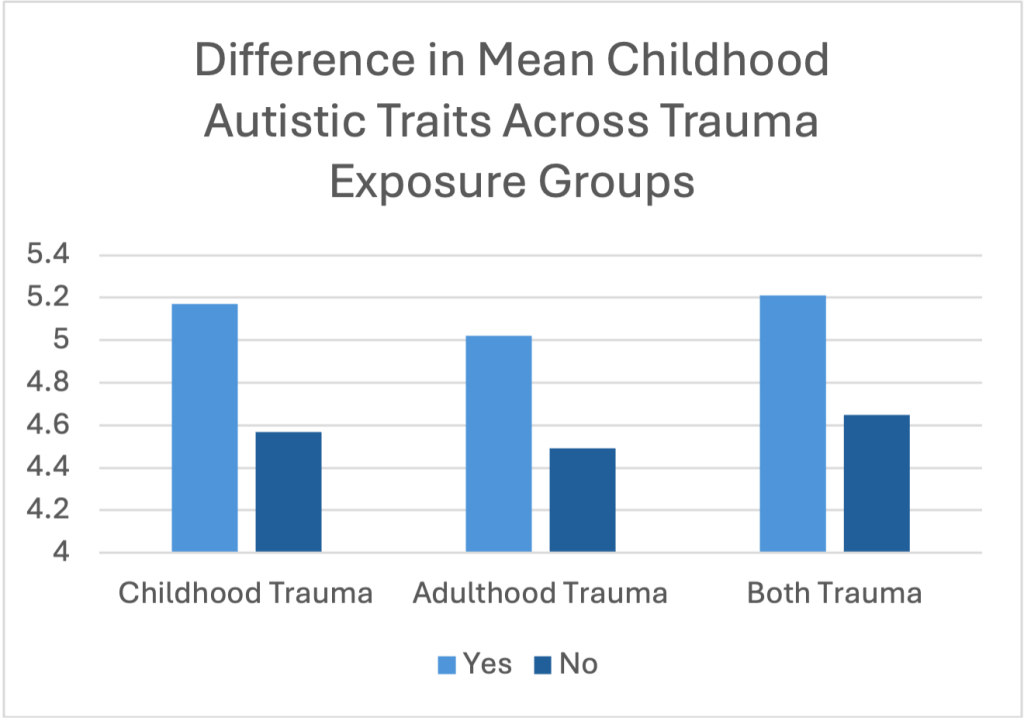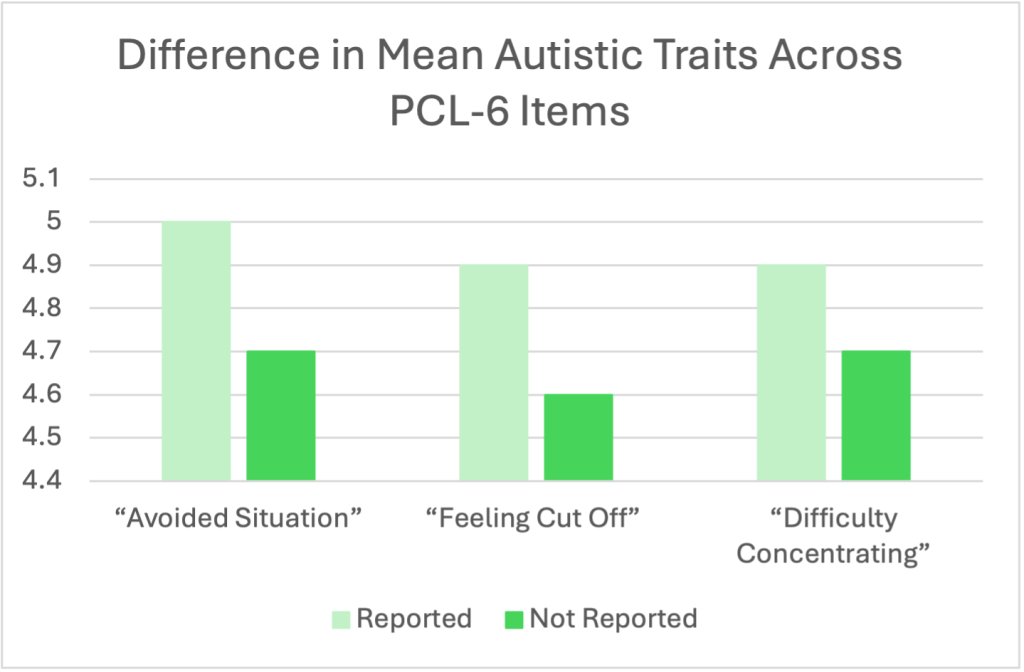CoTEDS placement student, Sky, outlines new research from the Twins Early Development Study, comparing childhood autistic traits in individuals who had or had not reported experiencing PTSD and trauma.
Autism is a developmental condition that affects how people communicate, interact socially, and experience the world.
Autistic children are three times more likely to experience victimization and bullying than typically developing children, meaning that autistic individuals are at a greater risk of developing trauma-related psychopathology, such as post-traumatic stress disorder (PTSD).
Symptoms of PTSD can involve intrusive memories, flashbacks, avoidance, and a heightened sense of threat. For autistic adults, these PTSD symptoms are often linked with higher levels of anxiety and depression, further impacting mental health. We were interested in diving deeper into the relationship between autism and trauma outcomes throughout life.
A recent study found that high autistic traits in childhood are associated with increased risk of trauma exposure and PTSD in adulthood. We wanted to build on this research, to look at autistic traits across the spectrum rather than just a diagnosis. Since diagnosed autism and general autistic traits share a genetic basis, looking at traits dimensionally can help us better understand autism-related experiences in the general population.
For this project we compared childhood autistic traits between individuals who had, and those who had not reported experiencing PTSD symptoms and trauma. We looked at whether the life stage of the traumatic experience mattered, by further splitting the group by those who experienced trauma in childhood and/or adulthood. We also investigated whether the association between childhood trauma and autistic traits was influenced when adulthood trauma was also present. We used TEDS data from over 13,000 twins from the UK, to explore how early autistic traits relate to trauma exposure and PTSD symptoms later in life.
Autistic traits were measured at age 8 based on parent reports about their child’s communication skills, behaviour and other symptoms of autism. Trauma exposure was assessed by looking at whether participants self-reported experiencing trauma in childhood and adulthood. Current PTSD symptoms were measured with a brief 6-item screening tool.
We found that childhood autistic traits were higher in people who reported having experienced trauma compared to those with no trauma. Notably autistic traits were also higher for individuals reporting adulthood trauma, specifically domestic abuse, as opposed to only general traumatic events.
However, it is important to note that childhood trauma was measured before autistic traits. Therefore, it’s possible that some of the autistic traits being reported may reflect responses to earlier trauma. Future research should try to tease apart the timing and direction of these effects.
Building on this, we also found that higher reported autistic traits in childhood were associated with current reports of PTSD symptoms, specifically avoidance, emotional detachment, and concentration difficulties.
Recognising the relationship between autistic traits and trauma across the lifespan may help guide future approaches to support and intervention. Identifying individuals with higher autistic traits early on could help ensure that those who may be more vulnerable to traumatic experiences receive appropriate, preventative support. Interventions that are both trauma-informed and sensitive to neurodevelopmental differences may be especially important in helping individuals build resilience and access support.
Acknowledgements
I would like to thank my supervisors, Alice Quinton and Joanna Bright, for their guidance and support throughout this project, and all the TEDS participants for their contributions.
References
- American Psychological Association. (2023). APA Dictionary of Psychology. Dictionary.apa.org. https://dictionary.apa.org/autism-spectrum-disorder
- Brewin, C. R., Rumball, F., & Happé, F. (2019). Neglected causes of post-traumatic stress disorder. BMJ, l2372. https://doi.org/10.1136/bmj.l2372
- Frissa, S., Hatch, S. L., Fear, N. T., Dorrington, S., Goodwin, L., & Hotopf, M. (2016). Challenges in the retrospective assessment of trauma: comparing a checklist approach to a single item trauma experience screening question. BMC Psychiatry, 16(1). https://doi.org/10.1186/s12888-016-0720-1
- Glaesmer, H., Schulz, A., Häuser, W., Freyberger, H. J., Brähler, E., & Grabe, H.-J. (2013). [The childhood trauma screener (CTS) – development and validation of cut-off-scores for classificatory diagnostics]. Psychiatrische Praxis, 40(4), 220–226. https://doi.org/10.1055/s-0033-1343116
- Hoover, D. W., & Kaufman, J. (2018). Adverse childhood experiences in children with autism spectrum disorder. Current Opinion in Psychiatry, 31(2), 128–132. https://doi.org/10.1097/yco.0000000000000390
- Kerns, C. M., Newschaffer, C. J., & Berkowitz, S. J. (2015). Traumatic Childhood Events and Autism Spectrum Disorder. Journal of Autism and Developmental Disorders, 45(11), 3475–3486. https://doi.org/10.1007/s10803-015-2392-y
- Khalifeh, H., Oram, S., Trevillion, K., Johnson, S., & Howard, L. M. (2015). Recent intimate partner violence among people with chronic mental illness: Findings from a national cross-sectional survey. British Journal of Psychiatry, 207(3), 207–212. https://doi.org/10.1192/bjp.bp.114.144899
- Lockhart, C., Bright, J., Ahmadzadeh, Y., Breen, G., Bristow, S., Boyd, A., Downs, J., Hotopf, M., Palaiologou, E., Rimfeld, K., Maxwell, J., Malanchini, M., McAdams, T. A., McMillan, A., Plomin, R., & Eley, T. C. (2023). Twins Early Development Study (TEDS): A genetically sensitive investigation of mental health outcomes in the mid‐twenties. JCPP Advances, 3(2). https://doi.org/10.1002/jcv2.12154
- Quinton, A. M. G., Freya Rumball, Ronald, A., Fisher, H. L., Arseneault, L., Happé, F., & Danese, A. (2025). Autistic traits in childhood and post‐traumatic stress disorder as young adults: a cohort study. Journal of Child Psychology and Psychiatry. https://doi.org/10.1111/jcpp.14163
- Robinson, E. B. (2011). Evidence That Autistic Traits Show the Same Etiology in the General Population and at the Quantitative Extremes (5%, 2.5%, and 1%). Archives of General Psychiatry, 68(11), 1113. https://doi.org/10.1001/archgenpsychiatry.2011.119
- Rumball, F. (2018). A Systematic Review of the Assessment and Treatment of Posttraumatic Stress Disorder in Individuals with Autism Spectrum Disorders. Review Journal of Autism and Developmental Disorders, 6. https://doi.org/10.1007/s40489-018-0133-9
- Scott, F. J., Baron-Cohen, S., Bolton, P., & Brayne, C. (2002). The CAST (Childhood Asperger Syndrome Test). Autism, 6(1), 9–31. https://doi.org/10.1177/1362361302006001003
- Smith, P., Dalgleish, T., & Meiser-Stedman, R. (2019). Practitioner review: Posttraumatic stress disorder and its treatment in children and adolescents. Journal of Child Psychology and Psychiatry, 60(5). https://doi.org/10.1111/jcpp.12983
- Weathers, F. W., Litz, B. T., Herman, D. S., Huska, J. A., & Keane, T. M. (1993, October). The PTSD Checklist (PCL): Reliability, validity, and diagnostic utility. In annual convention of the international society for traumatic stress studies, San Antonio, TX (Vol. 462).




